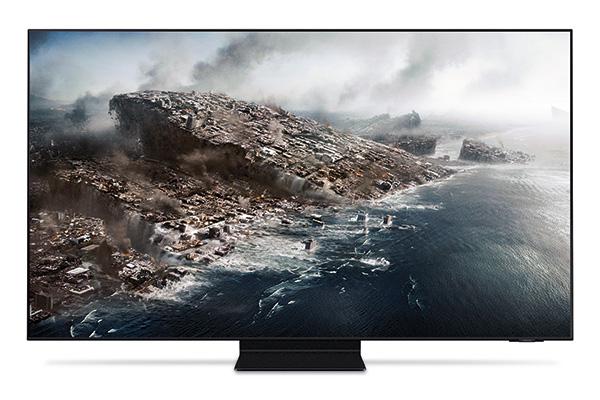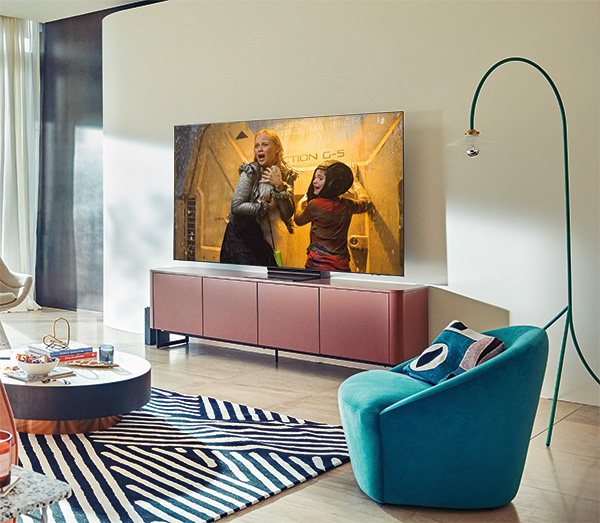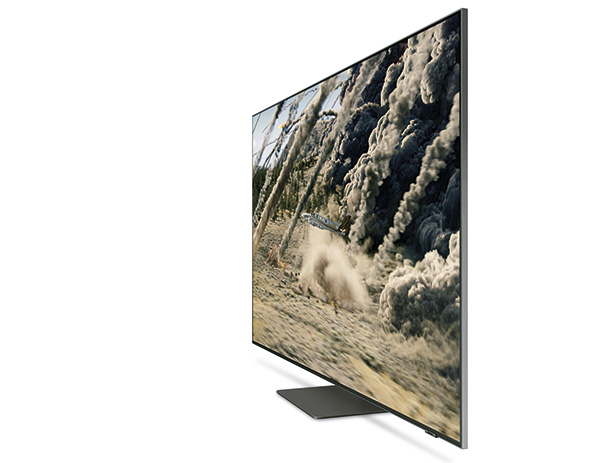Samsung QE65QN95A 4K HDR Neo QLED TV review

 While premium LCD TVs have long had brightness on their
side, they’ve always had trouble controlling exactly where that brightness goes, something that's arguably become more of
a picture quality concern with the step up to HDR content.
Enter Samsung's QE65QN95A, the brand's first TV to utilise Mini LED backlight technology.
While premium LCD TVs have long had brightness on their
side, they’ve always had trouble controlling exactly where that brightness goes, something that's arguably become more of
a picture quality concern with the step up to HDR content.
Enter Samsung's QE65QN95A, the brand's first TV to utilise Mini LED backlight technology.
Mini LED TVs do away with the usual lens and packaging associated with regular LEDs, allowing many more of them to be fitted behind an LCD panel. This opens the door to much finer control over how much light is pumped into different parts of the picture – provided the TV has the processing power and image analysis tools to drive such a sophisticated system effectively.
The technology, known in Samsung-land as Neo QLED, makes its debut on this £3,000 4K range-topper, and is also a feature on some of the brand's new 8K models. Head further down the TV chain, and regular full-array LED screens continue under the QLED moniker.
Samsung QE65QN95A design and connections
The shift to Mini LED has enabled Samsung to make the 65QN95A much trimmer than its recent predecessors. The frame around the screen is vanishingly narrow, too, while cable spaghetti haters will be pleased to hear that it ships with an external connections box that delivers everything
to the screen – even power – via a single cable.
All four of the box's HDMI inputs support the 4K/HDR/120Hz feeds the new Xbox and PS5 consoles are capable of outputting. They also offer Auto Low Latency Mode (ALLM) switching, where the TV activates its low-lag Game mode automatically when a gaming source is detected, plus variable refresh rates. In fact, the QE65QN95A is the first TV officially licensed for FreeSync Premium Pro, as well as handling the standard HDMI 2.1 VRR system and (unofficially) Nvidia G-Sync.
In other gaming news, this is also the first TV available to support the 21:9 and 32:9 aspect ratios of some PC games, while Samsung's new Game Bar dashboard tells you at a glance what gaming options you’ve got selected, and the format of game feed the TV is receiving. And as for that Game mode, I measured an input lag of just 9.2ms with 1080p/60Hz sources, the lowest such figure I’ve seen on a TV. Samsung has thoughtfully also provided a option that lets you introduce a touch of motion processing, to make pans look smoother, that only ups the input lag to 14ms.
Samsung QE65QN95A features
Moving on to video rather than game credentials, the 65QN95A’s single most exciting feature is its 792 separate dimming zones, each capable of simultaneously outputting different levels of brightness. The most dimming zones seen on a Samsung LCD TV before now is 480 – and last year’s flagship 4K TV only got 120. The potential impact this could have on contrast performance is mouthwatering, and it's here combined with extreme huge brightness figures of up to 2,700 nits (measured on a 10 per cent white HDR window). Even the Filmmaker Mode preset, which has been calibrated to meet the accuracy demands of the independent UHD Alliance, hits peaks north of 1,600 nits.
This TV debuts other fresh ideas beyond Mini LED. For example, to help the get best from the bijou backlight, Samsung has cooked up a 'Quantum Matrix' system that includes local dimming, power distribution and a new Black Detail Boost feature (for enhancing shadow detail reproduction) within its processing remit. Meanwhile, wider image processing is handled by a new Neo Quantum Processor, which, says Samsung, draws on the AI picture quality learnings of no less than 16 separate neural networks. Last year’s processor only had the results of one neural network to work with.
The 65QN95A’s Smart features are provided by Samsung’s Eden platform, with voice control capability and a huge roster of apps and streaming services. There’s a new green element to the TV's features, too, in the shape of a solar-powered smart remote.

Samsung QE65QN95A 4K HDR performance
Feeding the TV a few of my preferred torture-test 4K Blu-ray scenes reveals that Samsung’s move to Mini LED has worked out very nicely. Subjective contrast is sky-high, and backlight precision is exemplary. It feels like a genuine step-change in LED TV performance.
My personal favourite improvement is that bright HDR objects surrounded by darker backdrops are no longer being dimmed to limit backlight clouding problems, as they have been with many recent Samsung models. During the opening of Venom on 4K Blu-ray, where a distant ship is highlighted against the blackness of space, and subsequently falls in flames from the night sky, these bright objects really keep hold of their intensity.
Thanks to Mini LED, moreover, this extra punch with HDR objects isn't accompanied by any significant backlight blooming.
Basically the 65QN95A solves almost entirely the main bugbear I’ve had with Samsung full-array local dimming (FALD) TVs over the past few seasons.
The starfield in the opening of Venom also reveals the Mini LED backlight improvements aren’t just about light extremes. I could also see both more stars and more general intensity in those stars than I've become accustomed to with Samsung FALD models. Similarly, the sequence where Patrick Hockstetter runs into Pennywise while exploring a dark sewer in It (4K Blu-ray) was awash with subtle details in the dimly lit walls.
Black levels are absolutely inky at all times. This is the only LCD screen I can remember that completely blends in to a fully darkened room during fade to blacks. It also fades into and emerges out of full-black frames with excellent smoothness and near-black control, presumably another sign of the combined benefits of Mini LED lighting and nuanced processing behind it.
Perhaps unsurprisingly, deep blacks and high, consistently maintained brightness feeds into a stellar colour performance. During Venom's sequences in Carlton Drake’s colourfully lit laboratories, the intensity of the blue and red lighting is nothing short of dazzling, a glorious example of what wide colour gamuts and high HDR brightness can do.
Crucially, there’s no hint of thinness or washing out in even the most explosive of these colour tones, as Samsung’s QLED (Quantum Dot) colour technology can be driven at high levels of brightness without suffering desaturation.

The Venom disc boasts a detailed and clean-looking UHD image – and the 65QN95A does full justice to it. Heavily textured shots of Tom Hardy’s stubbled face and his ‘lived in’ apartment are brilliantly resolved.
Something to note is that the filter this TV applies to its screen to deliver its (impressively) wide viewing angles and reduced onscreen reflections creates a very fine horizontal line structure over the image. This, however, only becomes visible if you sit closer to the screen than anyone in their right mind likely would. It doesn't negatively impact resolution from any remotely sensible viewing distance.
Motion is handled well, so long as you avoid Samsung's rather messy default Auto settings and instead choose a Custom option with blur and judder components set to around four each.
Samsung QE65QN95A SDR and gaming performance
While this flatscreen is literally made for HDR and 4K,
it still performs admirably with HD and SDR. Upscaling,
in particular, is state-of-the-art; the brainpower behind Samsung's Neo Quantum processor works wonders on
HD pictures without exaggerating grain or throwing undue emphasis on what should be ‘background’ picture elements. SDR colour and light levels, meanwhile, prove a walk in the park for a screen as capable of such Herculean dynamics.
In some ways the 65QN95A’s pictures are even more exciting for gaming than video. Its huge brightness, colossal colour response and immense detail help the likes of Call Of Duty: Cold War and Demon’s Souls (both PlayStation 5) leap off the screen, while the support for all forms of variable refresh rates and 120Hz gaming delivers some of the smoothest, sharpest and cleanest gaming visuals I’ve experienced. Using the Game presets does have an impact on processing, though, meaning a little backlight blooming can creep in. This is especially true in FreeSync mode – my recommendation here is to reduce colour temperature from Warm 2 to Standard, knock the local dimming to Low and set the Contrast Enhancer tool to High.
One fly remains in the Samsung ointment. This 4K flagship is conversant with the dynamic HDR10+ standard, but doesn’t support the more widely available Dolby Vision format. This shouldn't come as a surprise to AV enthusiasts, because Samsung has never made a Dolby Vision-capable TV, but for those who intend to do a lot of viewing via UHD Blu-ray and Netflix it's an irritating spec omission.
More minor niggles are some occasional mild 'dirty screen effect' (noticeable in large swathes of white or grey), and the extreme left and right edges of the picture sometimes looking a shade darker than the rest.
Samsung QE65QN95A audio performance
Having put so much effort into its new Mini LED platform, you could have forgiven Samsung
for leaving this TV's audio on
the backburner. Yet the sound system here is also upgraded to
a 4.2.2-channel, 60W array equipped with Samsung’s startlingly effective Object Tracking Sound system (and in the 'OTS+' guise of last year's 8K model). It's a little restrained in terms of peak volume and forward impact perhaps, but capable of a meaty, immersive and largescale soundstage
with precise effects placement. There's no onboard Dolby Atmos decoding though, so you'll need to bitstream out.
Samsung QE65QN95A verdict
The final word on Samsung’s new TV belongs to its price. While £3,000 is clearly not cheap for a 65in set, it’s actually no more than you had to pay
for 2020’s equivalent 4K model, the QE65Q95T, when it launched. And as this Mini
LED makeover serves up
a significantly superior performance – arguably the most all-round exciting 4K LCD picture in town – that makes it seem like a bargain.
HCC Verdict
Samsung QE65QN95A
Price: £3,000
www.samsung.com/uk
We say: This Mini LED debutante is a roaring success, bringing Samsung's trademark LCD brightness and black levels together with far fewer compromises than ever before.
Overall: 5/5
Specifications
4K: Yes. 3,840 x 2,160 TUNER: Yes. Freeview HD CONNECTIONS: 4 x HDMI inputs; optical digital audio output; RF port; 3 x USB; Ethernet 4K/120 PLAYBACK: Yes SOUND (CLAIMED): 60W BRIGHTNESS (CLAIMED): N/A CONTRAST RATIO (CLAIMED): N/A DIMENSIONS (off stand) 1,446(w) x 828(h) x 25.4(d)mm WEIGHT (off stand): 24.5kg
FEATURES: Neo Quantum processing engine; Quantum Matrix Mini LED local dimming control; Game Bar; Eden smart system; Object Tracking Sound; Q-Symphony audio system; Wide Viewing Angle; FreeSync Premium Pro; VRR support; ALLM; external connections box; Wi-Fi; Bluetooth
 |
Home Cinema Choice #351 is on sale now, featuring: Samsung S95D flagship OLED TV; Ascendo loudspeakers; Pioneer VSA-LX805 AV receiver; UST projector roundup; 2024’s summer movies; Conan 4K; and more
|

















































